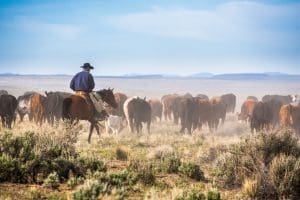By Chris McClure Contributing Editor
I awoke this morning to the sounds of the wind as it swooped across the flat plains from the Southwest. The promise of warmer temperatures is welcome, but I was reminded of 2010 and 2011 when the wind never seemed to relent as the thermometer gained momentum on its way triple digits for day after blast-furnace day. I am optimistic this won’t be a return to that kind of weather.
The wind also brings the sounds of my neighbor’s small preconditioning yard this morning. That sound is near silence, which is unusual. There are no bawling calves. Instead, the yard is full of cows with a few bulls sprinkled into the mix. It seems that everyone who can figure out a way to get a piece of the action is positioned for the anticipated demand for bred cows as we, hopefully, come out of the drought and into a more normal weather pattern. Even the weatherman is cooperating as he has indicated that La Niña has gone back to sleep, and El Niño awakened.
“Green up” has begun to the south and east of us as several fronts have brought needed rain. In the 1880s it would have signaled the beginning of drives taking cattle to northern markets. They generally followed the green up as it crept north on the warming temperatures and spring thunderstorms. Despite the movie portrayals of vast droves of thousands of cattle swarming up the trail, the reality was that most drives consisted of several hundred animals at a time – perhaps as many as 1,500 in a single trail herd. The grass couldn’t tolerate tens of thousands of animals trampling it at once. Those out front might get a belly full, but those in the back would be left with slim pickings.
The trails, if you could call them such, encompassed broad swaths of prairie and only became well defined at the crossings of what were often storm-engorged raging torrents, which we refer to as rivers. The herds spread out in order to find as much grass as possible so that they reached the westward-moving markets along the railroads to the north in good condition. You might say they were simply taking advantage of the free pasture as they slowly drifted northward.
That free pasture would be nice today considering the high feed prices we have been experiencing. Cattle are high because of strong demand for the number supplied, but the cost to get them fat means we are dragging quite a hefty anchor. I can’t imagine what yearlings would cost if we were feeding for $0.65 instead of $1.30 or more. But then again, we wouldn’t be seeing such short numbers so quickly if we hadn’t been dealing with high feed costs for cow herds for the last couple of winters. Way too much of our factory went to town, along with the potential yearling that will never exist.
Maybe we will rebuild more quickly than historically. It will create quite a pinch this year, but good rains in the right places, along with potentially record prices, could accelerate the diversion of heifers into the breeding herd to fill in the gaps left by the drought. If there are enough bred cows sitting in preconditioning yards and non-traditional reservoirs of genetics, maybe the cyclical pattern of regrowing our numbers will be shortened. I don’t think I am going to bet that way because prices for feeder heifers will create a strong temptation to divert some of that available grass to stocker programs rather than cow-calf. At some point, the consumer will push back against the high prices, and the quantity of animals demanded to meet their highly cultivated tastes will wane in light of inflationary pressures on their food budgets.
Yep, the winds are blowing, and the last few tumbleweeds are blowing eastward toward Oklahoma. Somewhere in the canyons along the edge of the Caprock there are bound to be vast piles of them in some wind-sheltered spot. I know the open pastures around me have been scoured clean. I’m sure they left plenty of seeds for next year as they tumbled across the dry grasses. All we need is a little rain.







